Seamus Daly is making gorgeous geodesic domes that offer a magical retreat from the elements in your very own garden The Cupola geodesic dome at this year's Bloom festival Seamus Daly, founder of Geodesic Domes Ireland Brian Fay, Eoin Fegan, Seamus Daly and Lorcan Golden of Geodesic Domes Ireland Hydrangea arborescens Dahlia In what must be one of the most picturesque locations for a craft business on our island, Seamus Daly and his team create futuristic greenhouses in a workshop overlooking a stunning valley in the Dublin Mountains. Formerly a building contractor, Seamus specialised in house extensions. Work was plentiful but full-on and around the clock.
He and his Danish wife, Nette, had a young family and Seamus wanted to spend more time with them as they grew up. He’d built the family home himself and it was the search for a greenhouse suited to a windy garden that led to a new enterprise. Ferocious winds can rip through the valley and locals advised that a greenhouse would be blown away.

Believing there must be a solution, Seamus remembered a structure he’d come across while leafing through an old book called Shelter . In its pages, Seamus learned of the work of Buckminster Fuller, who in 1948 came up with the name of ‘geodesic dome’ for a style of architectural dome created from rigid triangular elements. Figuring that this could be a solution for a windblown garden, Seamus began investigating where to source a greenhouse dome.
They were available online but the quality seemed poor. And so he decided that he’d have a go at building his own. Seamus Daly, founder of Geodesic Domes Ireland Armed with drawings purchased from a YouTuber for £50, his first dome took three weeks and stood outside the house for four months, without glazing.
Seamus had the dome bug. He started on another. This one was better, so he clad it in glass, delighted he’d figured out the puzzle.
The family planted it up and decked it out with furniture used for birthday parties and sleepovers. Visitors were smitten and wanted domes for themselves. I understand why.
From the outside, it’s a striking architectural feature, which looks wonderful surrounded by planting or dropped into any rural landscape. Step inside and the feeling is quite magnificent. You’re in a bubble, a living space where greenhouse plants and people thrive.
And because of the inherent strength of the shape, the domes make remarkably comfortable, relaxing retreats, even in the middle of a storm. The decision to set up a business to make the domes came in a jolt that woke Seamus out of his sleep at 5am one morning. He grabbed his computer, worked on a plan till 7am and woke up Nette.
She was apprehensive, understanding that the domes’ construction was complex and problematic; they were slow to make and the last thing the family needed was to start another business. But they decided to give it a go. A Danish friend built a website and designed a logo, which allowed Seamus to at least feel he had a business.
However, it was one without any customers. The Local Enterprise Office offered support with grants, courses and invaluable business mentoring. Convinced that once people experienced the structures, they’d love them, his focus became looking for a space at the Bloom garden festival.
He tried in 2020 but had no luck. He landed one the next year in an inauspicious space beside the bins and behind the bistro. Seamus’s instincts were correct: visitors to the show who found the dome loved it and five were sold that weekend.
The building in the workshop began in earnest and soon schools around the country discovered that these domes made great outdoor classrooms. Four years down the line, Geodesic Domes Ireland is thriving. Sales of the latest model were so good at Bloom this year that Seamus doubled his workforce.
Brian Fay, Eoin Fegan, Seamus Daly and Lorcan Golden of Geodesic Domes Ireland It’s a lovely, homegrown success story: timber from Wicklow, glass from Tipperary; the team craft, deliver and install these architectural gems countrywide. No chemicals are used during production and the process is CO2-neutral. The future for the firm involves developing more designs and working with cross-border trade body InterTradeIreland, to bring it to Northern Ireland.
So what’s behind people’s love of these dome-shaped greenhouses? Seamus says the answer to that is easy: “We’re used to being in boxes, [but] entering one of our domes is like walking into a hug.” geodesicdomes.ie Hydrangea arborescens Hydrangea arborescens ‘Annabelle’ ‘Annabelle’, with her delightful round globes of creamy white flowers, is often a signature plant with garden designers who wish to create a cool, sophisticated and expensive look.
The flowers start off pale green and mature to white before fading to a limey green so they blend seamlessly with most colour schemes. They’re also beautiful as they go to seed so will provide interest for many months. Grow in moist, well-drained fertile soil in sun or partial shade.
Make sure hydrangeas don’t dry out — ‘hydros’ is Greek for water. Prune in spring to around a foot in height, just above a pair of buds. Dahlia We were wondering what might be feasting on this dahlia.
We have checked for vine weevil but there seems to be no evidence of that. Thanks, Siobhan Hi Siobhan, It’s unlikely to be vine weevils — they leave very distinctive notch-shaped bites in the leaves. This looks more like slugs and snails have been eating the dahlia, and there have been a lot of these creatures around the garden this year.
To protect your other dahlias, I’d recommend placing a shallow saucer of beer near the plants overnight and you will find your culprits in the morning worse for wear. Repeat as necessary. Submit your gardening questions to Diarmuid via his Instagram @diarmuidgavin using the hashtag #weekendgarden Join the Irish Independent WhatsApp channel Stay up to date with all the latest news.



















